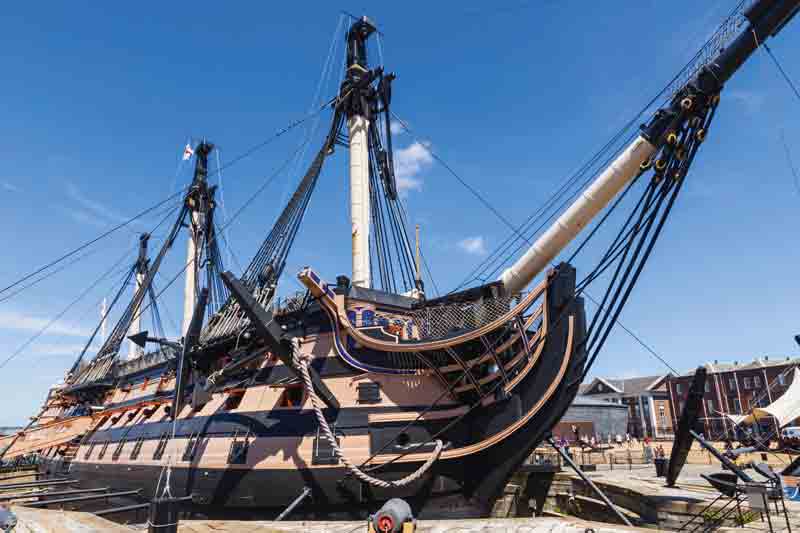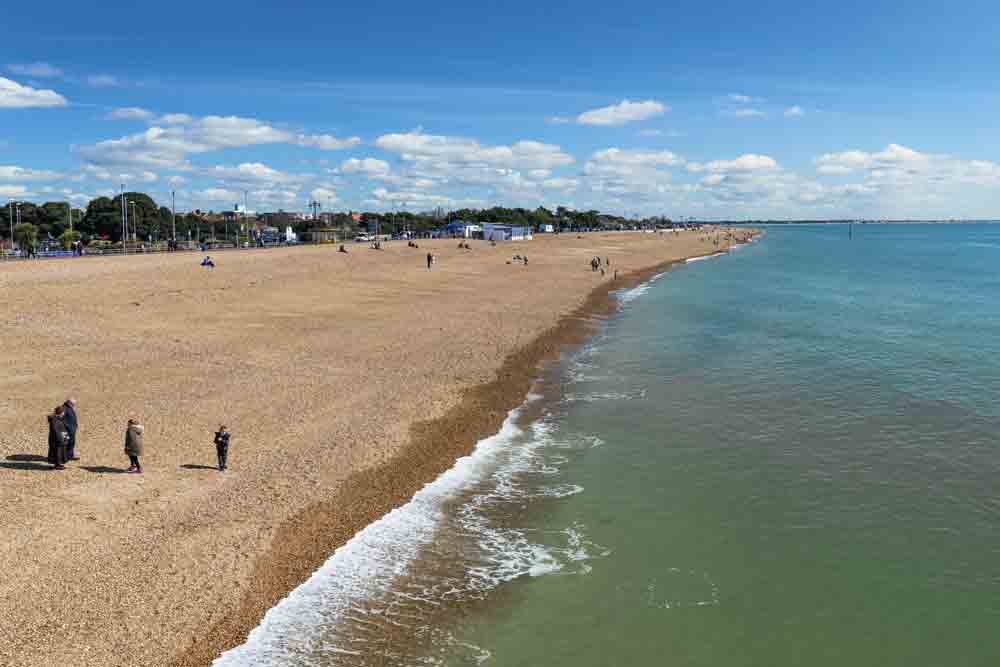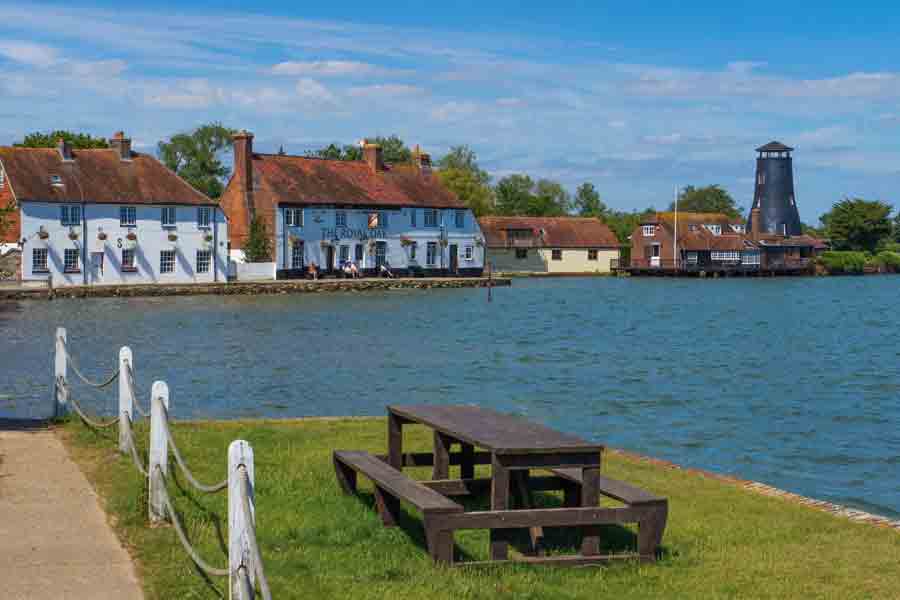Motorhome travel: A weekend break in Portsmouth
Portsmouth’s iconic Spinnaker Tower, Nelson’s flagship HMS Victory, HMS Warrior and the four-mile-long seafront at Southsea are visible from the Channel ferries – but we knew that there was far more to see.
So, we decided to spend a couple of nights at Southsea Leisure Park, starting our shortbreak by visiting Portsmouth’s award-winning Historic Dockyard, top of our list of must-dos.
HMS Warrior, with her proud figurehead, huge masts and extraordinary mass of rigging, is an impressive sight.
After exploring Warrior’s upper deck, we climbed down steep wooden steps to the gun deck with its row upon row of wooden tables where most of the crew lived and worked. Far below were the engines and boilers, along with vast storage facilities for all the coal needed to supply the power.
HMS Victory and Lord Nelson

HMS Victory will forever be associated with the death of Lord Nelson and, on the upper deck, we found a plaque showing the exact spot where he fell.
Below deck is Nelson’s elaborate campaign bed, and grand and extremely spacious officers’ cabins aft – a world away from the horribly cramped living conditions of the ordinary sailors. The ship’s surgery, with its crude instruments, saws, blood-stained bandages and even a ‘severed foot’, was a grim reminder of the harshness of being at sea in those days.
Next to HMS Victory is The Mary Rose Museum. Once through the turnstile we were engulfed in darkness, automated doors and the very latest technology. Large colourful dioramas, illuminated pictures and touch screens brought the Mary Rose’s story to life.
Behind huge glass walls were the remains of the vessel itself. Looking at the size of the ancient timbers that had been brought to the surface after 437 years under the Solent, made me realise the scale of what has been achieved.
At Boathouse 4 we watched boat-building apprentices practising their skills and children attempting to climb up and down the giant mast. Our harbour boat trip (included in our tickets) was an excellent way to round off our busy day.
Almost next door to the dockyard is Gunwharf Quays. Despite its military-sounding name, this shopping centre has chic eating places and bars, all cleverly integrated with some of the original features and buildings from when the site was HMS Vernon.
This is also home to the Spinnaker Tower. We admired the tower from below but, we’re told, on a clear day you can see for 23 miles. For the brave, the glass Sky Walk is 328ft above the ground.
The area known as Old Portsmouth was a hive of activity. Ferries from the Isle of Wight docked next to fishing boats; dredgers and yachts, freighters and pilot boats negotiated the narrow harbour entrance and historic pubs were filling up.
.jpg)
Our plan was to explore the length of the waterfront by bike, starting at Southsea Common. Cycle routes cross the grassy expanses, which are also very popular for jogging, kite flying, picnics and festivals.
We passed the fun fair and aquarium and watched the Isle of Wight hovercraft drive up onto the beach, before arriving at the D-Day Museum. Part of the museum is devoted to the magnificent Overlord Embroidery, a locally made 272ft-long work of art depicting the events surrounding that day. Motorhomes are allowed to park at the museum.
Nearby is Southsea Castle, built by Henry VIII. Henry watched the sinking of his favourite warship, the Mary Rose, from these ramparts.
Leaving Tudor times, we entered the modern era at South Parade pier with the usual assortment of seaside attractions.
The two stretches of water either side of the city could not be more different. Portsmouth Harbour to the west is where the commercial shipping and the Royal Navy are to be found, whilst Langstone is far more peaceful with leisure craft and wildlife. Eastney, where the campsite is located, is by Langstone Harbour and close to the ferry that runs across to Hayling Island.

A waterside walk of 14 miles runs all around the harbour onto Hayling Island and back across the harbour entrance, encompassing the RSPB reserve at Farlington Marshes. Hayling Island also has plenty of cycle routes that we enjoyed, including the old Hayling Billy railway line. Bikes are carried for free on the ferry.
Portsmouth’s famous sons: Sir Arthur Conan Doyle and Charles Dickens
We particularly enjoyed Portsmouth City Museum. Sir Arthur Conan Doyle was a doctor who lived and worked in Southsea and it is where he wrote his first Sherlock Holmes story. The museum has a permanent exhibition containing intriguing archives.
Another famous son of Portsmouth was Charles Dickens. His father worked in the Royal Navy pay office and the house where he was born is now a museum.
The streets around Southsea, particularly Albert Road, have all kinds of quirky shops and some of the historic pubs appear little changed from the nineteenth century.

Whichever route you take off Portsea Island you cannot miss Portsdown Hill ahead of you. The long chalk ridge runs for about two miles and overlooks the whole of the Solent. At the top we found free car parking (no height barriers) and spectacular far-reaching views.
There are five Napoleonic forts across the hill, including Fort Nelson, home to the Royal Armouries Museum. However, the place we wanted to visit was Southwick, on the far side of Portsdown Hill.
Southwick (pronounced Suthick) is a quintessential English village with thatched cottages and ancient church. It is part of a 7,500-acre estate owned by the Thistlethwayte family. Southwick’s history goes back to the twelfth century. However, the village’s most significant connections are with WWII and D-Day.
In 1943, when the Allies wished to invade Europe, Churchill and Roosevelt needed a base to plan the invasion and Southwick House eventually became the headquarters for Operation Overlord – or D-Day, as we know it today. The village was a hive of activity with visiting generals and admirals, prime ministers and even King George VI.
The Red Lion and the Golden Lion inns were kept busy with new customers including Churchill, Eisenhower and Montgomery. Inside the Golden Lion we found the walls covered with photos and memorabilia from those days. The Golden Lion also has the advantage of the Southwick Brewhouse at the rear, which sells over 250 varieties of draft beers, craft beer, real ales, stouts, porters and ciders from all of the local brewers.
During our stay we’d discovered a surprising variety of things to see and do. Throughout the year Southsea and Portsmouth – or Pompey as it is locally known – hosts exhibitions, boat races, concerts and festivals, plus special one-off events, while the open spaces are perfect for outdoor activities rain or shine.
This feature was originally published in the December 2018 edition of MMM. To buy a back issue, click here. You can enjoy more travel inspiration here.







.jpg)



Recent Updates
Engine management lights: all you need to know
What is the engine management light? What does it mean, and what do I have to do? ...
Motorhome air suspension: all you need to know
Motorhomes are heavy and the additional weight of equipment and height of the bodywork can increase the loads ...
Motorhome WiFi: how to get better motorhome internet
Staying connected on the move is more and more essential, so relying on campsite WiFi isn't an option – here ...
A class of their own - our guide to A-class motorhomes
Thinking of trading up to an A-class, or even going straight to the top of the motorhome tree? We guide you ...
Explore overseas on a motorhome dream tour
Enjoy exotic travel in a campervan or motorhome by hiring, swapping with someone else or exporting your ...
Motorhome water systems: everything you need to know
On-board water is an important part of every motorhome – here’s everything you need to know ...
Campervanning in Europe: what you need to know
Whether you're planning a leisurely drive through the French countryside, navigating bustling city streets in ...
Campervan security: all you need to know
With thefts on the increase, it’s important to know how to keep your campervan secure and prevent campervan ...
Campervan furniture: everything you need to know
Our campervan experts guide you through all the essentials for your campervan, including tables, chairs, ...
Campervan finance: how to fund your purchase
Here we look at the different types of campervan finance available, to help you decide what’s the best option ...
Other Articles
Britain’s best used motorhomes
Want a great motorhome without paying the premium for a new one? Here's a guide to the best you can get in the pre-owned market for each layout, ...
Which motorhome? Choosing the perfect motorhome for you
Choosing a motorhome or campervan is one of the biggest buying decisions you’ll ever make, so it's important ...
Campervan washroom essentials: stay fresh on the road
Our guide will take you through the campervan washroom essentials you'll need so you're well-prepared for ...
Dogs in campervans: all you need to know
Follow our advice and your dog will enjoy campervanning as much as you do ...
Electric campervans: all you need to know
Our guide will take you through everything you need to know about electric campervans and what the future ...
Motorhome electrics: a complete guide to your motorhome electrical set-up
Motorhome electrics can dramatically enhance the convenience and comfort of your vehicle – but they can be ...
Lighting for campervans: all you need to know
We guide you through all the lighting options available for you and your campervan, including interior ...
Electric bikes for motorhomes: our ultimate guide
Read our comprehensive guide to electric bikes for motorhome owners, helping you add electric power to your ...
Our guide to 'cheap' motorhomes in 2024
If you're on the hunt for an affordable new motorhome, this is the best place to start – we've rounded up a ...
Campervans in winter: all you need to know
Here's your guide to preparing your campervan for the colder months, whether you will be using it or putting ...